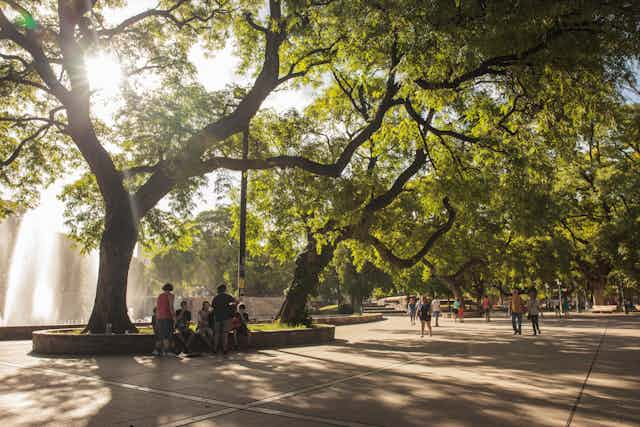In cities around the world, trees are often planted to help control temperatures and mitigate the effects of the “urban heat island”. But while trees have been called “nature’s air conditioners”, in practice, scientists often have difficulty demonstrating their cooling properties.
The most obvious way to measure the cooling effect of trees would be to compare the air temperature in parks with that in nearby streets. But this method often comes up with disappointing results: even in large, leafy parks, the daytime air temperature is usually less than 1°C cooler than in the stuffy streets, and at night the temperature in parks can actually be higher.
To explain this contradiction, we need to think more clearly about the physics of heat flows in our cities, and the scale of the measurements we are taking.
Shady days
Theoretically, trees can help provide cooling in two ways: by providing shade, and through a process known as evapotranspiration. Locally, trees provide most of their cooling effect by shading. How warm we feel actually depends less on local air temperature, and more on how much electromagnetic radiation we emit to, and absorb from, our surroundings. A tree’s canopy acts like a parasol, blocking out up to 90% of the sun’s radiation, and increasing the amount of heat that we lose to our surroundings by cooling the ground beneath us.

All up, the shade provided by trees can reduce our physiologically equivalent temperature (that is, how warm we feel our surroundings to be) by between seven and 15°C, depending on our latitude. So it’s no surprise that, in the height of summer, people throng to the delicious coolness of the shade provided by London parks, Parisian boulevards, and Mediterranean plazas.
Trees can also cool down buildings – especially when planted to the east or west – as their shade prevents solar radiation from penetrating windows, or heating up external walls. Experimental investigations and modelling studies in the USA have shown that shade from trees can reduce the air conditioning costs of detached houses by 20% to 30%.
But air conditioning is more common in some places than in others: for example, while three out of four Australian households have an air conditioner, they’re much less common in Northern Europe, leaving the population there more vulnerable to the harms of urban heat. During the 2003 European heatwave, there were 70,000 more deaths recorded, compared with equivalent cool periods. We urgently need more research to find out how much shade from trees could cool down the terraced houses and apartment blocks, where so many less well-off people live.
Beating the heat
Trees can also be used to tackle a bigger problem: the urban heat island. During periods of calm, sunny weather, the air temperature of cities can be raised above that of the surrounding countryside by up to 7°C, especially at night. In cities, the hard, dark asphalt and brick surfaces absorb almost all the incoming short-wave radiation from the sun, heating up to between 40°C and 60°C, and storing energy which is then released into the air during the still of night, when it can be trapped in the narrow street canyons.

Urban trees can counter this process by intercepting the radiation before it reaches the ground, and using the energy for evapotranspiration. Evapotranspiration occurs when the sun’s rays hit the trees’ canopy, causing water to evaporate from the leaves. This cools them down – just as sweating cools our skin – thereby reducing the amount of energy left to warm the air.
The effects of evapotranspiration can be quantified in two ways. First, you can measure the temperature of the tree canopy, which is typically much cooler than built surfaces – only 2°C to 3°C above air temperature. Unfortunately, we can’t really claim that this temperature difference is evidence of cooling capacity; leaves would be cooler than built surfaces even if they weren’t losing water, because they are cooled more effectively by convection.
A better method is to calculate the cooling effect of a tree directly, by measuring how much water it is losing. You can do this by measuring the sap flow up its trunk, or the water loss from single leaves. These methods show that tree canopies can divert over 60% of the incoming radiation to evapotranspiration. Even a small (4m high) Callery pear tree – a commonly planted species in Northern Europe – can provide around 6kW of cooling: the equivalent of two small air-conditioning units.
But there’s a catch: trees only provide this cooling effect when they are growing well. By measuring water loss from individual leaves, we showed that sparser, slower-growing plum and crab apple trees provided only a quarter of the cooling effect of the Callery pears. What’s more, the effectiveness of trees can be greatly reduced if the growing conditions are poor. We found that the transpiration of Callery pears could be reduced by a factor of five, if the roots were growing through compacted or poorly aerated soil. Much more research is needed on the relative performance of large and small trees, whether they’re planted on streets or in parks.
One final difficulty in working out the cooling power of trees is to determine how much a given tree’s evapotranspiration will actually reduce the air temperature. As so often in science, a modelling approach is needed, with physicists, engineers and biologists working together. We need to put realistic trees into detailed regional climate models, which can mimic the complex daily movements of air and energy through the city. Only then can we determine the regional benefits of the urban forest, and work out how to use trees to make our cities cooler and more pleasant places to live in.

